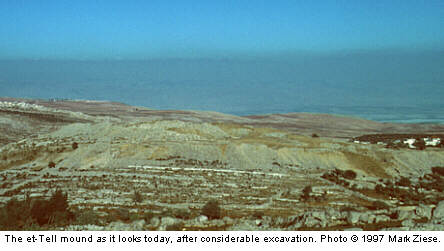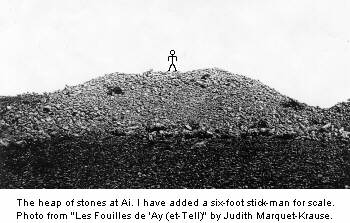
|
|
|
|
|
|
Home
About
Resources
anti-aging vitamins books
- A New Approach...
- The Exodus Happened 2450 B.C.
- Noah's Flood Happened 3520 B.C.
- Age of the Earth Collection
- Aging: Cause and Cure
- Bread from Heaven: The Manna Mystery Solved
newsletters
podcast
speaker for an event
time charts
videos
Topics
Overview
Biblical Chronology Dendrochronology Radiocarbon Dating Mt. Sinai Jericho Ai The Exodus Noah's Ark Imhotep/Joseph
Correspondence
- anti-aging vitamins
- antiquity of mankind
- ark search
- Bible chronology
- "The BC" publication
- Bryant Wood's critique
- calendars
- Heshbon
- horses and chariots in Egypt
- Jericho --- Joshua's curse
- lifespan research
- missing millennium: reception
- missing millennium: textual
- Mt. Sinai
- Noah's Flood
- Philistines
- radiocarbon
- Sodom and Gomorrah
- teaching science and creation
- the Exodus
- tree rings
- virtual history
- young earth creation
Contact Us
Is there evidence of the Conquest at Ai?The following article is based on Dr. Aardsma's book A New Approach to the Chronology of Biblical History from Abraham to Samuel. A more thorough discussion can be found there.Et-Tell, the Remains of AiAi was the second city Joshua's army attacked during the Conquest. The ruins of this city are a mound known to archaeology as et-Tell. A few individuals have questioned this identification, motivated by the fact that the archaeology at et-Tell at the traditional date for the Conquest does not fit the biblical account of the Conquest at all. However, the geography and topography of et-Tell closely match the biblical description of Ai.  The Bible records in Joshua chapter 8 that the Israelites defeated Ai, killed its 12,000 inhabitants, and burned the city. This event would leave a clear destruction layer. Dr. Aardsma's chronology places the Conquest ca. 2400 B.C., a full thousand years earlier than the traditional date of the Conquest. Does the archaeology at et-Tell at 2400 B.C. fit the biblical account of the Conquest? An Overview of Ai's HistoryAccording to biblical archaeology,Et-Tell was a city of 27.5a. [acres], settled in the Early Bronze Age IB (c. 3310 BCE) and occupied until the Early Bronze Age IIIB (c. 2400 BCE), at which time it was destroyed and abandoned. At the beginning of the Iron Age I (c. 1220 BCE), a 2.5-a. unwalled village was established on the acropolis area of the acient ruin. It was occupied until about 1050 BCE, and then abandoned. It was never resettled. [Callaway, Joseph A. "Ai" The New Encyclopedia of Archaeological Excavations in the Holy Land ed. Ephraim Stern. New York: Simon & Schuster, 1993.]  In the figure above, the solid horizontal lines represent periods of time during which Ai was an unwalled town. The rectangle represents time during which Ai was a walled city. The letters A and B mark the conventional (early and late) dates for the Conquest. The letter C marks the date of the Conquest according to Dr. Aardsma's biblical chronology. This summary of Ai's history clearly contradicts the idea that the Conquest happened ca. 1400 B.C., the traditional date. It is not hard to see why Ai has been a problem for traditional biblical chronology. The city was uninhabited for 1,000 years prior to ca. 1400 B.C., when traditional biblical chronology says Joshua destroyed the city. On the contrary, the archaeology from et-Tell fits very well with the Bible's account at Aardsma's date of 2400 B.C. The Destruction LayerJoshua 8:28 records: "So Joshua burned Ai and made it a heap forever, a desolation until this day" (NASB). The Bible clearly indicates that the city was burned when it was destroyed by Joshua. Judith Marquet-Krause conducted extensive excavations at et-Tell in the 1930's. She reported (original reference in French; translation by Mark Aardsma): The city dated back to the dawn of the Early Bronze and had been destroyed at the end of this same period, or at the very beginning of the Middle Bronze by a violent fire. [Marquet-Krause, Judith Les Fouilles de 'Ay (et-Tell), 1933-1935 (Bibliotheque Archeologique et Hisorique 45) Paris: 1949, 14.] The Heap of StonesThe Bible goes on to record, in Joshua 8:29 (NASB): And he hanged the King of Ai on a tree until evening; and at sunset Joshua gave command and they took his body down from the tree, and threw it at the entrance of the city gate, and raised over it a great heap of stones that stands to this day.Judith Marquet-Krause recorded the following paragraphs in her report on her excavation at Ai (translated from French):
 This heap of stones is a most exciting and persuasive piece of evidence. ConclusionThere is clear archaeological evidence from et-Tell of the biblical Conquest at Ai. The evidence was not recognized by the original excavators, however, because the traditional biblical chronology upon which they were relying misdated the Conquest by a full millennium. The foregoing article was based on Dr. Aardsma's book A New Approach to the Chronology of Biblical History from Abraham to Samuel. A more thorough discussion can be found there. |